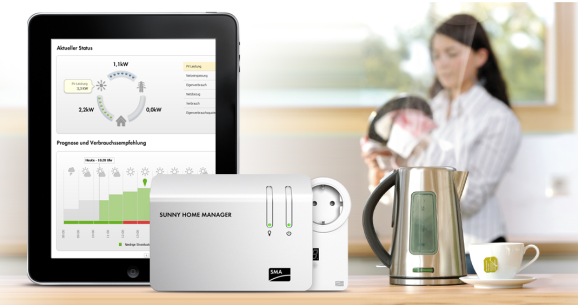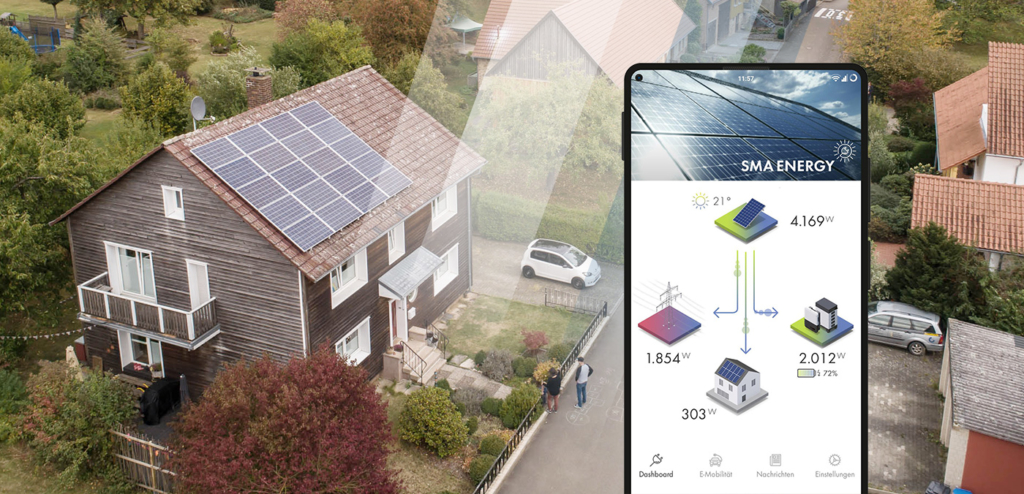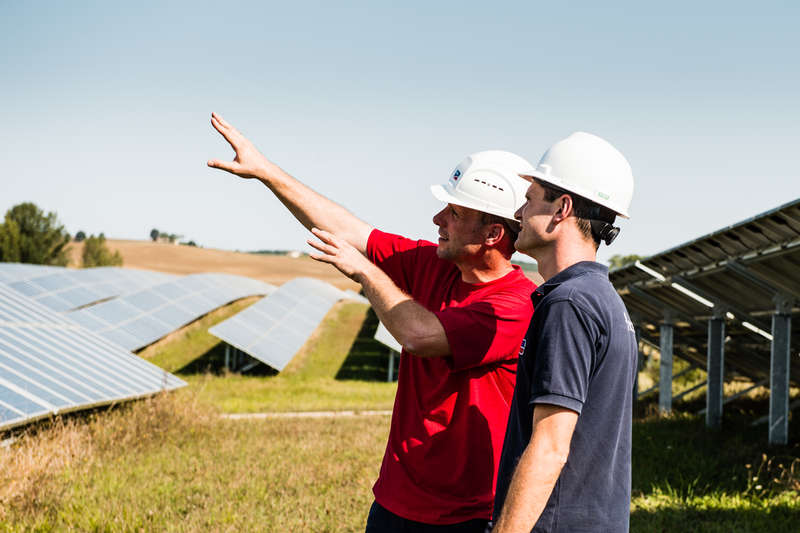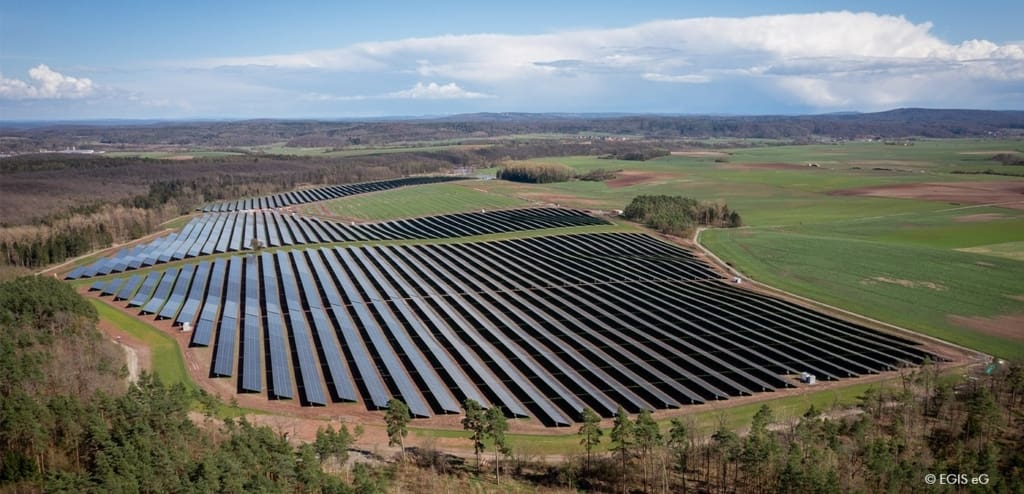A Day in the Life of the Sunny Home Manager

Making tea, doing the laundry, washing the dishes, drying hair, watching television. My family, the Thriftys, uses a lot of electrical appliances on a typical day. Let me tell you how I use and manage solar energy intelligently, not only to save electricity and money, but also to protect the environment.
– Midnight.
I live in the basement, right next to the electric meter – where all the household energy flows come together. It’s dark – only my own Bluetooth® LED bathes the room in a dim blue light. All is quiet. My family is sleeping, as they usually are this time of night.
The Sunny Portal contacts me, delivering the latest weather forecast and asking for status updates. Naturally, I’m always in touch with the rest of my team – the Sunny Boy inverters, the SMA radio-controlled sockets, and the other smart devices around the house. No problems there. Thanks – I say, and tell the Portal that my team and I are all fine. Tomorrow’s going to be a gorgeous day with plenty of sunshine – not much for me to do, but I’m still looking forward to it.
Before going to bed, the Thrifty family loaded the washing machine and dishwasher for tomorrow and switched the various SMA radio-controlled sockets to automatic mode. This leaves it up to me to control them. I’m expecting about 30 kWh of solar power tomorrow. If I manage it well, I can cover the 5kWh that the two appliances need – just under half of my home’s total daily demand – with solar electricity. I can work with that. And I’ll still have enough time to generate my timetable for use of the major electric appliances.
Mr. Thrifty instructed me to optimize the family’s energy use for maximum efficiency – and so I’ll try to use the cheapest possible power. Right now, that’s solar power.
I’m not the only one active at this late hour; my friend Sunny Island is also at work. He charged up his batteries yesterday with solar energy, and now he’s covering the load until the sun comes up again tomorrow morning. We don’t need the utility grid right now; we’re fully self-sufficient.
– 6:00 a.m.
I register a slightly higher load, probably because someone has turned on the bathroom light. Mr. and Mrs. Thrifty are up. I expected that because they always get up at 6:00. Everything is going according to plan – exactly the way I like it.
– 7:00 a.m.
Slight deviation from the plan. Ordinarily, they make two cups of coffee – today it’s three cups. The first rays of sunlight strike the solar modules, and my friends the Sunny Boys start to wake up. The day can begin.
– 7:30 a.m.
Hmmm… Unfortunately, the Sunny Boys can’t deliver as much energy right now as the weather forecast predicted. I wonder why? Clouds?? Early morning fog?? I had actually wanted to start the washing machine at 9:15 and then run the dishwasher after that. No problem, though. I’ll just wait for the latest weather report from the Sunny Portal and start the appliances a little later. Of course, I hope I can get that done before it’s time to start cooking lunch around noon. No worries, if necessary, I can wait and run the dishwasher in the afternoon.
– 7:45 a.m.
Another spike in energy consumption that’s untypical for this time of day. It seems that Mr. Thrifty is quickly ironing a shirt and trousers for work, while Mrs. Thrifty has finished her shower and is drying her hair. Okay, now it’s getting complicated, but by no means impossible. I hope the forecaster wasn’t totally wrong and the sun still shines as promised.
– 8:15 a.m.
Well, the iron and hair dryer are off now, but there’s not much sunshine yet. Too bad. Here’s another weather report from the Sunny Portal: “Not much irradiation in the morning hours. Morning fog until 10:00 – followed by sunshine.” Okay, let’s take a look and make a new plan. Start the washer at 10:00 a.m. – after its water has heated, I’ll run the dishwasher at 10:23 a.m. Then pause both of them while Mrs. Thrifty does her cooking for the day. Any leftover electricity will go into the battery storage system.
– 9:30 a.m.
Well, what do you know – here comes the sun at last. Now the Sunny Boys are delivering more power than expected. Far more than the household is even using. Listening to the two inverters humming, you can almost feel the energy. Terrific. Here we go with the washing machine. New schedule for all the other appliances – everything half an hour earlier. Washing machine and dishwasher: Ready, set, go! The Sunny Boys feed the excess energy into the utility grid.
– 11:00 a.m.
Oh, dear. I’m registering a significant drop in PV production. Clouds again! Especially on beautiful days like this, clouds tend to gather around noon. Because everything’s already running, I don’t need to make a new plan. But given the change in the weather, I’ll update my forecast.
– 11:20 a.m.
The washing machine and dishwasher are done now. Checking her smartphone, Mrs. Thrifty sees this. Now the odds are very good that she’ll move the laundry to the dryer soon, so I can activate it for the afternoon.
– Noon
Right at midday, the peak consumption period, the battery storage is full – that’s good. If we run short of energy, we can draw on the battery. I’m holding my breath now. For one thing, passing clouds are keeping the panels from generating much power – and for another, Mrs. Thrifty is cooking up a storm, using a lot of electricity. But all goes without a hitch. The battery storage system supplies the power that Mrs. Thrifty needs even though PV panels can’t provide at the moment.
– 1:30 p.m.
The cooking is done – the clouds are gone, the sun is out again. Hurray! Too bad Mrs. Thrifty hasn’t loaded the dryer yet. The battery storage level is down to 70 percent, but now the system can start to charge again.
– 2:00 p.m.
As I hoped, after her midday snooze Mrs. Thrifty moved the laundry from the washer into the dryer and activated it. Based on the current load, I decide to start it in ten minutes. And the battery storage is full again.
– 3:45 p.m.
The dryer is done. Now Mrs. Thrifty fills the washing machine again and starts it. That means washing another load today, and then drying it this evening. That’s cutting it close. Although there’s enough PV power right now, in about four hours the sun will go down. That doesn’t leave much leeway. Alright, start the washing machine now.
– 5:00 p.m.
The washing machine is done. Mrs. Thrifty is moving the laundry to the dryer, so I could still start it. Unfortunately, it’s already late in the day, and there’s only a little bit of solar energy left. It won’t be enough to run the dryer on PV energy alone. But Mrs. Thrifty has instructed me to have the laundry dry by 9 p.m. at the latest, no matter what. I’ll try my best to do what she wants. So I start the dryer right away instead of waiting until morning. That way, I can use the rest of the PV energy and top it off with electricity from the battery.
– 7:00 p.m.
Mr. Thrifty turns on the television to watch the news and then a documentary. No problem for me because powering a TV isn’t really a challenge.
– 9:00 p.m.
The sun goes down – that’s the end of solar energy for today. Checking out the data on the Sunny Portal, Mr. Thrifty is delighted. No power purchased from the grid, 12kWh of our own energy used, 33kWh stored – that’s the way it should be.
– 11:30 p.m.
The Thrifty family has gone to bed – all I register now is the basic consumption. I had a great day – plenty of excitement, and no power from the grid. We’ll see whether tomorrow brings more of the same. I’m optimistic!
(Blog entry written with Christian Höhle, Development Engineer – Communications Technology)
For more information, please visit the following link:
Sunny Home Manager product page





It is really is surprising how energy habits change for the better, quite cathartic. The home has a static load that never goes away even in the most energy efficient homes. It may not be possible to run big appliances when you want but that small amount of power from ‘cloudy’ panels is reducing or eliminating the static load during daylight hours.